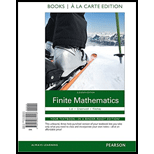
Finite Mathematics, Books a la Carte Plus MyLab Math Access Card Package (11th Edition)
11th Edition
ISBN: 9780133886818
Author: Margaret L. Lial, Raymond N. Greenwell, Nathan P. Ritchey
Publisher: PEARSON
expand_more
expand_more
format_list_bulleted
Concept explainers
Question
Chapter B, Problem 38E
To determine
To solve: The given equation.
Expert Solution & Answer
Want to see the full answer?
Check out a sample textbook solution
Students have asked these similar questions
-
Let n = 7, let p = 23 and let S be the set of least positive residues mod p of the first (p − 1)/2
multiple of n, i.e.
n mod p, 2n mod p, ...,
p-1
2
-n mod p.
Let T be the subset of S consisting of those residues which exceed p/2.
Find the set T, and hence compute the Legendre symbol (7|23).
23
32
how come?
The first 11 multiples of 7 reduced mod 23 are
7, 14, 21, 5, 12, 19, 3, 10, 17, 1, 8.
The set T is the subset of these residues exceeding
So T = {12, 14, 17, 19, 21}.
By Gauss' lemma (Apostol Theorem 9.6),
(7|23) = (−1)|T| = (−1)5 = −1.
Let n = 7, let p = 23 and let S be the set of least positive residues mod p of the first (p-1)/2
multiple of n, i.e.
n mod p, 2n mod p, ...,
2
p-1
-n mod p.
Let T be the subset of S consisting of those residues which exceed p/2.
Find the set T, and hence compute the Legendre symbol (7|23).
The first 11 multiples of 7 reduced mod 23 are
7, 14, 21, 5, 12, 19, 3, 10, 17, 1, 8.
23
The set T is the subset of these residues exceeding
2°
So T = {12, 14, 17, 19, 21}.
By Gauss' lemma (Apostol Theorem 9.6),
(7|23) = (−1)|T| = (−1)5 = −1.
how come?
Shading a Venn diagram with 3 sets: Unions, intersections, and...
The Venn diagram shows sets A, B, C, and the universal set U.
Shade (CUA)' n B on the Venn diagram.
U
Explanation
Check
A-
B
Q Search
田
Chapter B Solutions
Finite Mathematics, Books a la Carte Plus MyLab Math Access Card Package (11th Edition)
Ch. B - Write each exponential equation in logarithmic...Ch. B - Prob. 2ECh. B - Prob. 3ECh. B - Prob. 4ECh. B - Prob. 5ECh. B - Prob. 6ECh. B - Prob. 7ECh. B - Prob. 8ECh. B - Prob. 9ECh. B - Write each logarithmic equatio in exponential...
Ch. B - Prob. 11ECh. B - Prob. 12ECh. B - Prob. 13ECh. B - Prob. 14ECh. B - Prob. 15ECh. B - Prob. 16ECh. B - Prob. 17ECh. B - Prob. 18ECh. B - Prob. 19ECh. B - Evaluate each logarithm without using a...Ch. B - Prob. 21ECh. B - Prob. 22ECh. B - Prob. 23ECh. B - Prob. 24ECh. B - Prob. 25ECh. B - Prob. 26ECh. B - Use the properties of logarithms to write each...Ch. B - Prob. 28ECh. B - Use the properties of logarithms to write each...Ch. B - Prob. 30ECh. B - Prob. 31ECh. B - Prob. 32ECh. B - Prob. 33ECh. B - Prob. 34ECh. B - Prob. 35ECh. B - Prob. 36ECh. B - Prob. 37ECh. B - Prob. 38ECh. B - Prob. 39ECh. B - Prob. 40E
Knowledge Booster
Learn more about
Need a deep-dive on the concept behind this application? Look no further. Learn more about this topic, subject and related others by exploring similar questions and additional content below.Similar questions
- 3. A different 7-Eleven has a bank of slurpee fountain heads. Their available flavors are as follows: Mountain Dew, Mountain Dew Code Red, Grape, Pepsi and Mountain Dew Livewire. You fill five different cups full with each type of flavor. How many different ways can you arrange the cups in a line if exactly two Mountain Dew flavors are next to each other? 3.2.1arrow_forwardBusinessarrow_forwardWhat is the area of this figure? 5 mm 4 mm 3 mm square millimeters 11 mm Submit 8 mm Work it out 9 mmarrow_forward
- No chatgpt pls will upvotearrow_forwardFind all solutions of the polynomial congruence x²+4x+1 = 0 (mod 143). (The solutions of the congruence x² + 4x+1=0 (mod 11) are x = 3,4 (mod 11) and the solutions of the congruence x² +4x+1 = 0 (mod 13) are x = 2,7 (mod 13).)arrow_forwardhttps://www.hawkeslearning.com/Statistics/dbs2/datasets.htmlarrow_forward
- Determine whether each function is an injection and determine whether each is a surjection.The notation Z_(n) refers to the set {0,1,2,...,n-1}. For example, Z_(4)={0,1,2,3}. f: Z_(6) -> Z_(6) defined by f(x)=x^(2)+4(mod6). g: Z_(5) -> Z_(5) defined by g(x)=x^(2)-11(mod5). h: Z*Z -> Z defined by h(x,y)=x+2y. j: R-{3} -> R defined by j(x)=(4x)/(x-3).arrow_forwardDetermine whether each function is an injection and determine whether each is a surjection.arrow_forwardLet A = {a, b, c, d}, B = {a,b,c}, and C = {s, t, u,v}. Draw an arrow diagram of a function for each of the following descriptions. If no such function exists, briefly explain why. (a) A function f : AC whose range is the set C. (b) A function g: BC whose range is the set C. (c) A function g: BC that is injective. (d) A function j : A → C that is not bijective.arrow_forward
arrow_back_ios
SEE MORE QUESTIONS
arrow_forward_ios
Recommended textbooks for you
- Algebra & Trigonometry with Analytic GeometryAlgebraISBN:9781133382119Author:SwokowskiPublisher:Cengage
 Big Ideas Math A Bridge To Success Algebra 1: Stu...AlgebraISBN:9781680331141Author:HOUGHTON MIFFLIN HARCOURTPublisher:Houghton Mifflin Harcourt
Big Ideas Math A Bridge To Success Algebra 1: Stu...AlgebraISBN:9781680331141Author:HOUGHTON MIFFLIN HARCOURTPublisher:Houghton Mifflin Harcourt

Algebra & Trigonometry with Analytic Geometry
Algebra
ISBN:9781133382119
Author:Swokowski
Publisher:Cengage

Big Ideas Math A Bridge To Success Algebra 1: Stu...
Algebra
ISBN:9781680331141
Author:HOUGHTON MIFFLIN HARCOURT
Publisher:Houghton Mifflin Harcourt
Introduction to Algebra: Using Variables; Author: Professor Dave Explains;https://www.youtube.com/watch?v=WZdZhuUSmpM;License: Standard YouTube License, CC-BY